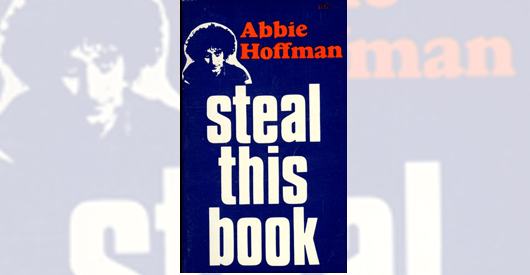
Like anyone entering a new world with strange rules and arcane traditions, new self-publishers are often confused about what they have to do, what they’re supposed to do, what they really ought to do. It’s like there’s a secret society and if you don’t know the secret handshake everyone will see that you’re a hopeless newbie.
But, hey, we’re indie authors and indie publishers. We follow the conventions when we need to, because we decide whether or not it’s something that will help us toward our publishing goal. If I have a book I think a lot of librarians might like, I’m going to take the time and expense to put a P-CIP data block and an index in that book.
Sometimes you just have to remind yourself that since you’re the author and the publisher, you can do pretty much whatever you want. Like Abbie Hoffman who, in 1971, insisted on titling his book Steal This Book. He flouted convention, and many booksellers wouldn’t carry the book, but he made an indelible point.
So here’s a list of things you really don’t have to do if you don’t want to. After all, it’s your book. If you don’t have a good reason to follow established conventions, or the conventions are irrelevant to your publishing plan, then maybe you shouldn’t bother. Take a look:
Top 10 Things Self-Publishers Don’t Need to Do
- Register your copyright—There’s no copyright “police” that will come and arrest you if you don’t register your copyright. Your copyright is inherent in the work when you create it, the registration process is just to supply proof of ownership in case you need it. Maybe you’ll never need it?
- Get CIP, LCCN, PCN—All those acronyms. Who needs it? Nobody says you have to apply for Library of Congress Control Numbers or anything else. If you know your marketing plan, maybe you don’t need them.
- Obtain an ISBN for your book—An International Standard Book Number identifies the publisher of the book and the individual title. It’s like a universal stocking number for inventory control and database retreival. Maybe you’re going to sell all of your books by hand, off the back of your truck. In that case an ISBN might be a waste.
- Put a Barcode on your book—Let’s face it, a Bookland EAN Barcode is an ugly, blotchy rectangle to have on your book. If you’ve already passed on the ISBN number, you won’t be needing one of these, because it’s simply a scannable version of the ISBN.
- Put your book for sale at Amazon—Nobody can force you to put your book on Amazon.com, where it will join millions of other books in the biggest retail establishment in the history of the world. This trusted source for books—and pots and pans and generators and bicycles—ships millions of books each year. But if you hate corporate America and its evil ways, don’t put your book there. Stick to the local independent stores and hand selling, you’ll be happier.
- Hire an editor—Editors may want to tell you how well you’re communicating your ideas, and they want money to do it, too. Nobody says you have to put up with or pay for book editing.
- Hire a book designer—As one of my clients once said to me, “You just put the page numbers on, right?” Your word processor can do that, and a book cover as well.
- Establish a strong online presence—Major publishers are encouraging their authors to “build their author platform” and indie authors start gathering their tribe online even before they publish. But some people are uncomfortable online, or putting themselves out in front. You can just say no.
- Publish in all formats—Readers have so many reading choices now, self-publishers are issuing their books in print, Kindle, iBooks, PDF and other formats in response. But it’s also fine to stick to one format, and sometimes there are good reasons to do so. We probably won’t be seeing expensive technical manuals as unprotected ebooks anytime soon.
- Market your book—Lots of people publish books without a profit motive. They are more interested in spreading their ideas, and the whole idea of “marketing” may seem like it could ruin the impression you’re trying to make. But you know what? It’s not mandatory. You can print your books, donate them to libraries, give them away, or leave them next to the Bibles in motel rooms. Really, the choice is yours.
What I’m trying to get at is that self-publishing is an act of personal expression. It can be whatever you want it to be. So often we’re creating books that we want to sell in the marketplace, and with which we want to compete with books from “the big boys.”
In that scenario we know we have to create a professional product, nothing less will do.
But it’s also refreshing to realize that it’s a matter of choice. Maybe you want to put your Introduction at the end of the book. Maybe you don’t need page numbers. You can use convention or purposefully ignore it.
With the move to ebooks and digital products of all kinds, the forms we’ve become accustomed to for books are starting to change. With that change will come a huge opportunity to influence the new forms that will develop for text and multi-media storytelling.
Takeaway: As independent publishers we get to choose how closely we want to follow book industry conventions, and when we want to ignore them.
Resource
Abbie Hoffman’s Steal This Book (1971) was boycotted by many booksellers, for obvious reasons. It is now available on Scribd.com, for free. You can steal it here.


